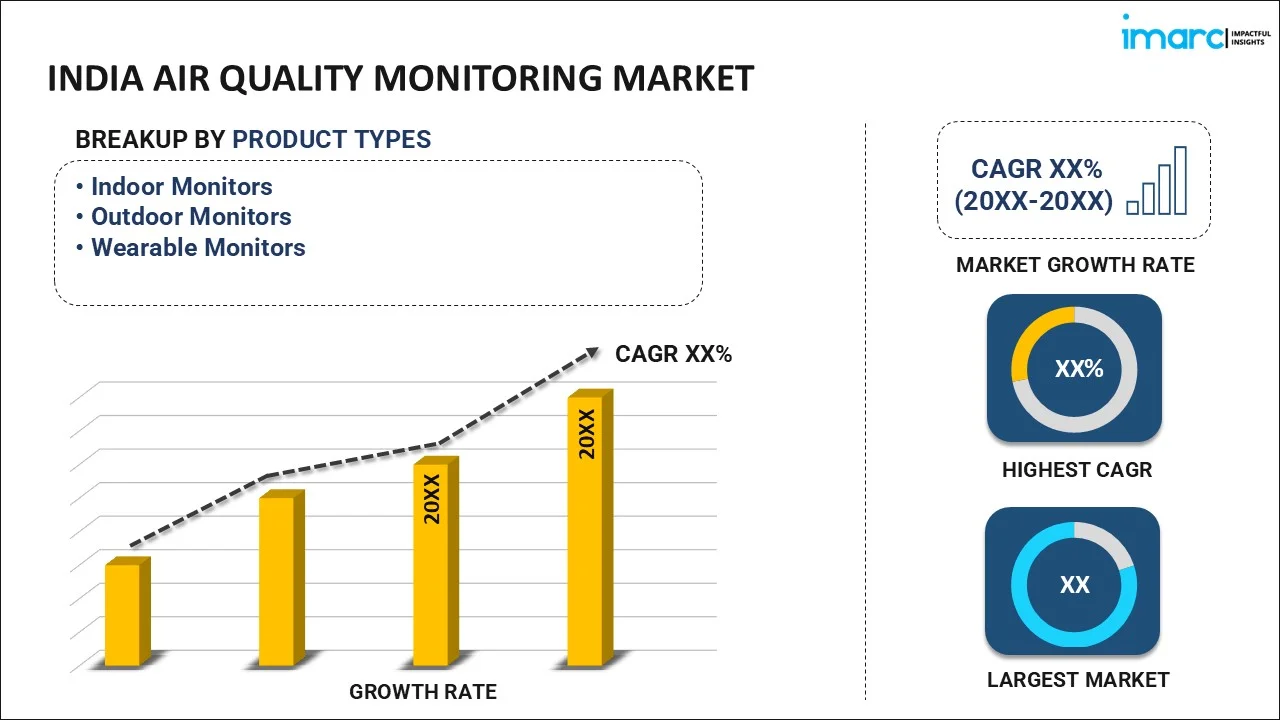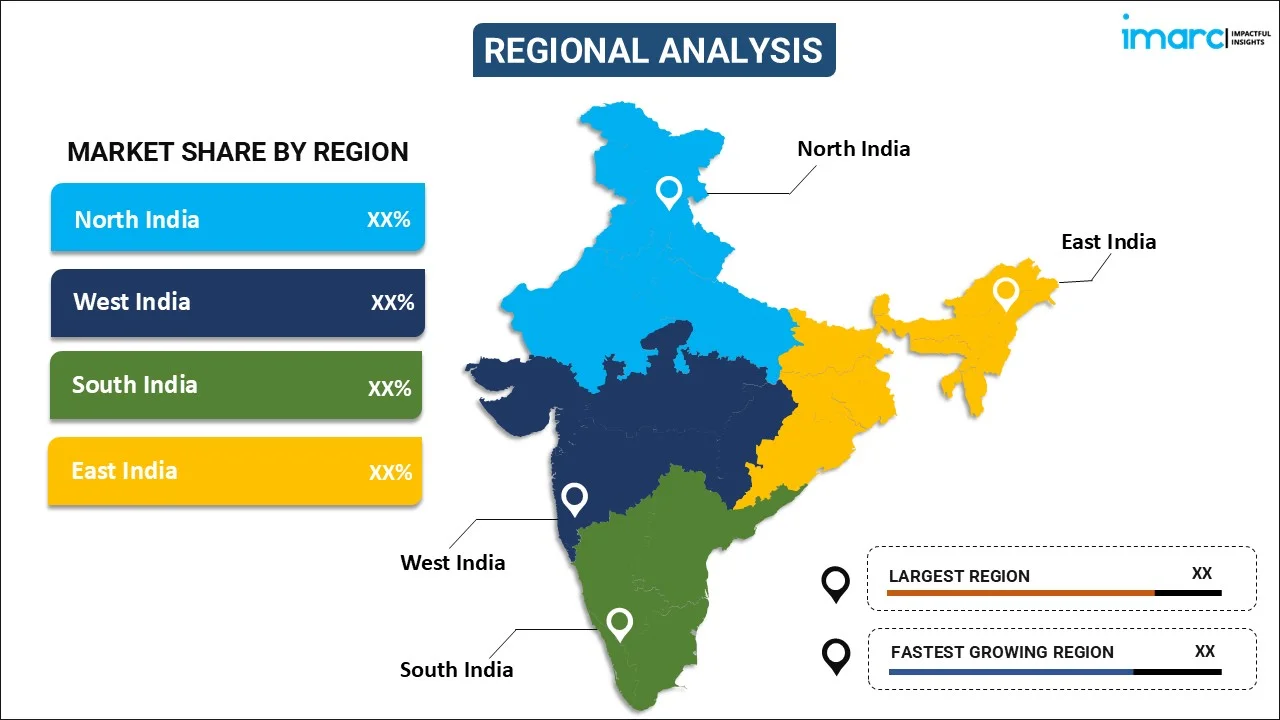
India Air Quality Monitoring Market Size, Share, Trends and Forecast by Product Type, Pollutant, Sampling Method, End User, and Region, 2025-2033
India Air Quality Monitoring Market Size and Share:
The India air quality monitoring market size reached USD 169.97 Million in 2024. Looking forward, IMARC Group expects the market to reach USD 292.07 Million by 2033, exhibiting a growth rate (CAGR) of 6.20% during 2025-2033. The market is driven by rising pollution levels, stringent government regulations, increasing public awareness, rapid urbanization, and industrial expansion. Advancements in sensor technology, growing smart city initiatives, and escalating health concerns about respiratory diseases further fuel the India air quality monitoring market share.
|
Report Attribute
|
Key Statistics
|
|---|---|
|
Base Year
|
2024
|
|
Forecast Years
|
2025-2033
|
|
Historical Years
|
2019-2024
|
| Market Size in 2024 | USD 169.97 Million |
| Market Forecast in 2033 | USD 292.07 Million |
| Market Growth Rate (2025-2033) | 6.20% |
India Air Quality Monitoring Market Trends:
Stringent Government Regulations
The Indian government has introduced stringent regulations and policies to combat deteriorating air quality. Programs like the National Clean Air Programme (NCAP) aim to reduce particulate matter pollution by 20-30% by 2024. The Central Pollution Control Board (CPCB) mandates industries, municipalities, and transport sectors to monitor and report emissions. Compliance with air quality standards is now critical for businesses, leading to increased adoption of air monitoring systems. Additionally, regulatory bodies encourage deploying low-cost sensors and advanced monitoring networks to ensure better enforcement, thereby propelling the India air quality monitoring market growth. For instance, in June 2024, on World Environment Day, Secretary of MeitY, Shri S Krishnan, launched the Indigenous Air Quality Monitoring System (AQ-AIMS) and introduced the Air-Pravah App. These are created using technologies supported by MeitY. Secretary Shri S Krishnan stated, “This is a highly cost-effective, ‘Make in India’ solution, offered in three variants based on the requirements of industries. The system had undergone extensive testing and validation for different air parameters. The Additional Secretary of MeitY, Shri Bhuvanesh Kumar stated, “MeitY is backing R&D efforts from concept validation to product creation to address the increasing demands of the industries.”
Technological Advancements in Air Monitoring
The air quality monitoring market is benefiting from rapid advancements in sensor technology, IoT, and artificial intelligence. Low-cost air sensors, satellite-based monitoring, and AI-driven predictive analytics provide more accurate and real-time data. These innovations help authorities, researchers, and industries track pollution sources and take preventive measures efficiently. Smart city initiatives across India also emphasize integrating smart air monitoring devices into urban infrastructure, creating a positive India air quality monitoring market outlook. The increasing affordability of portable and wearable air quality monitors enables individuals to access real-time pollution data, driving the adoption of advanced monitoring solutions in both government and private sectors. For instance, in November 2024, Google introduced Air View+, an AI-powered air quality monitoring system throughout India, allowing both citizens and government officials to obtain real-time pollution information via Google Maps. The system utilizes a network of sensors that track key pollutants such as PM2.5, PM10, CO2, NO2, Ozone, and VOCs every minute. Climate tech companies Aurassure and Respirer Living Sciences have deployed these sensors in key areas like administrative buildings, shopping centers, and utility poles to enhance population coverage.
India Air Quality Monitoring Market Segmentation:
IMARC Group provides an analysis of the key trends in each segment of the market, along with forecasts at the regional level for 2025-2033. Our report has categorized the market based on product type, pollutant, sampling method, and end user.
Product Type Insights:

- Indoor Monitors
- Outdoor Monitors
- Wearable Monitors
The report has provided a detailed breakup and analysis of the market based on the product type. This includes indoor monitors, outdoor monitors, and wearable monitors.
Pollutant Insights:
- Chemical Pollutant
- Physical Pollutant
- Biological Pollutant
The report has provided a detailed breakup and analysis of the market based on the pollutant. This includes chemical pollutant, physical pollutant, and biological pollutant.
Sampling Method Insights:
- Active/Continuous Monitoring
- Passive Monitoring
- Intermittent Monitoring
- Stack Monitoring
The report has provided a detailed breakup and analysis of the market based on the sampling method. This includes active/continuous monitoring, passive monitoring, intermittent monitoring, and stack monitoring.
End User Insights:
- Government Agencies and Academic Institutes
- Commercial and Residential Users
- Petrochemical Industry
- Power Generation Plants
- Pharmaceutical Industry
- Others
A detailed breakup and analysis of the market based on the end user have also been provided in the report. This includes government agencies and academic institutes, commercial and residential users, petrochemical industry, power generation plants, pharmaceutical industry, and others.
Regional Insights:

- North India
- South India
- East India
- West India
The report has also provided a comprehensive analysis of all the major regional markets, which include North India, South India, East India, and West India.
Competitive Landscape:
The market research report has also provided a comprehensive analysis of the competitive landscape. Competitive analysis such as market structure, key player positioning, top winning strategies, competitive dashboard, and company evaluation quadrant has been covered in the report. Also, detailed profiles of all major companies have been provided.
India Air Quality Monitoring Market News:
- In May 2024, Thermo Fisher Scientific, based in the US, revealed the start of production for Air Quality Monitoring System (AQMS) analysers in India. The analysers will be designed, produced, and tested at Thermo Fisher's facility located in Nasik, Maharashtra.
- In February 2023, Oizom, a leader in creating air quality monitoring solutions, achieved remarkable progress in enhancing the precision of its monitors to unparalleled heights. The firm is dedicated to creating cutting-edge technologies and enhancing air quality monitoring systems. In addition, they consistently engage in validation studies carried out by global authorities like AQMD, York University, and the HKEPD (Hong Kong Environmental Protection Department) standards to guarantee their devices exceed all performance benchmarks across various climatic conditions.
India Air Quality Monitoring Market Report Coverage:
| Report Features | Details |
|---|---|
| Base Year of the Analysis | 2024 |
| Historical Period | 2019-2024 |
| Forecast Period | 2025-2033 |
| Units | Million USD |
| Scope of the Report |
Exploration of Historical Trends and Market Outlook, Industry Catalysts and Challenges, Segment-Wise Historical and Future Market Assessment:
|
| Product Types Covered | Indoor Monitors, Outdoor Monitors, Wearable Monitors |
| Pollutants Covered | Chemical Pollutant, Physical Pollutant, Biological Pollutant |
| Sampling Methods Covered | Active/Continuous Monitoring, Passive Monitoring, Intermittent Monitoring, Stack Monitoring |
| End Users Covered | Government Agencies and Academic Institutes, Commercial and Residential Users, Petrochemical Industry, Power Generation Plants, Pharmaceutical Industry, Others |
| Regions Covered | North India, South India, East India, West India |
| Customization Scope | 10% Free Customization |
| Post-Sale Analyst Support | 10-12 Weeks |
| Delivery Format | PDF and Excel through Email (We can also provide the editable version of the report in PPT/Word format on special request) |
Key Questions Answered in This Report:
- How has the India air quality monitoring market performed so far and how will it perform in the coming years?
- What is the breakup of the India air quality monitoring market on the basis of type?
- What is the breakup of the India air quality monitoring market on the basis of pollutant?
- What is the breakup of the India air quality monitoring market on the basis of sampling method?
- What is the breakup of the India air quality monitoring market on the basis of end user?
- What is the breakup of the India air quality monitoring market on the basis of region?
- What are the various stages in the value chain of the India air quality monitoring market?
- What are the key driving factors and challenges in the India air quality monitoring market?
- What is the structure of the India air quality monitoring market and who are the key players?
- What is the degree of competition in the India air quality monitoring market?
Key Benefits for Stakeholders:
- IMARC’s industry report offers a comprehensive quantitative analysis of various market segments, historical and current market trends, market forecasts, and dynamics of the India air quality monitoring market from 2019-2033.
- The research report provides the latest information on the market drivers, challenges, and opportunities in the India air quality monitoring market.
- Porter's five forces analysis assist stakeholders in assessing the impact of new entrants, competitive rivalry, supplier power, buyer power, and the threat of substitution. It helps stakeholders to analyze the level of competition within the India air quality monitoring industry and its attractiveness.
- Competitive landscape allows stakeholders to understand their competitive environment and provides an insight into the current positions of key players in the market.
Need more help?
- Speak to our experienced analysts for insights on the current market scenarios.
- Include additional segments and countries to customize the report as per your requirement.
- Gain an unparalleled competitive advantage in your domain by understanding how to utilize the report and positively impacting your operations and revenue.
- For further assistance, please connect with our analysts.
 Inquire Before Buying
Inquire Before Buying
 Speak to an Analyst
Speak to an Analyst
 Request Brochure
Request Brochure
 Request Customization
Request Customization




.webp)




.webp)












